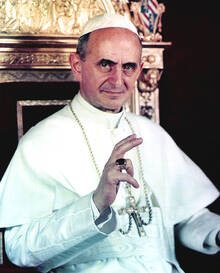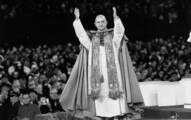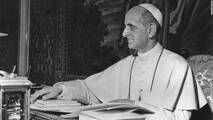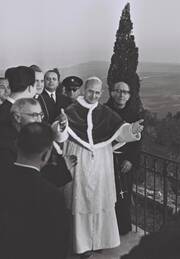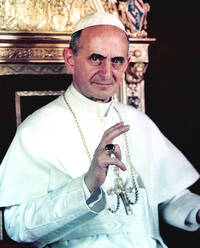St Paul VI - Papa Montini
Born on 26th September 1897 in Concesio, Brescia in the Kingdom of Italy. Four days later he was baptised Giovanni Battista Enrico Antonio Maria Montini. One of three brothers. Ordained priest on 29th May 1920, celebrating his first Holy Mass in Brescia in the Basilica of Santa Maria delle Grazie. He served in the Holy See's Secretariat of State from 1922, working very closely with Pope Pius XII from 1939; through WWII, Montini created an information office regarding prisoners of war and refugees, which from 1939 until 1947 received almost 10 million requests for information about missing persons and produced over 11 million replies.
Consecrated bishop on 12th December 1954, becoming Archbishop of Milan until his election as pope.
Created cardinal by St John XXIII on 15th December 1958 and elected Pope on 21st June 1963.
Died on the Feast of the Transfiguration, 6th August 1978.
Beatified on 19th October 2014 and canonized on 14th October 2018 by Pope Francis.
Motto - Cum Ipso in monte - With Him on the mountain
Feast day - 29th May (30th May in the Ambrosian rite).
Saint for the Unborn
It is a beautiful Providential sign that both the miracles that have been verified in the canonization process of Paul VI, the author of Humanae Vitae, concern unborn children. The first miracle (necessary for beatification) concerned the curing of an unborn child in California, USA, in the 1990s. The second miracle concerned the healing of an unborn girl, Amanda Maria Paola. On 23rd September 2014 Vanna Pironato (aged 35) was hospitalized due to the premature rupture of the placenta, with doctors declaring her pregnancy to be at great risk. On 29th October 2014, just ten days after Paul VI's beatification, Amanda's parents, Vanna and Alberto, went to the Santuario delle Grazie in Brescia to pray for Paul VI's intercession. The miracle was that Amanda survived for two more months in the womb despite the fact that the placenta was broken. Amanda was born on Christmas day, 25th December 2014. If you are praying for an unborn baby, Papa Paolo VI is definitely a great friend to ask for help and intercession!
Saint Paul VI made nine apostolic voyages, visiting all five continents during his pilgrimages:
1 - the Holy Land: Jordan, Israel & Palestine (4th - 6th January 1964)
2 - Lebanon & India (2nd - 5th December 1964)
3 - United States of America & the United Nations (4th - 5th October 1965)
4 - Shrine of Our Lady of Fatima, Portugal (Feast of Our Lady of Fatima, 13th May 1967)
5 - Turkey & Our Lady's House in Ephesus (25th - 26th August 1967)
6 - Colombia & Bermuda (22nd - 25th August 1968)
7 - Switzerland (10th June 1969)
8 - Uganda (31st July - 2nd August 1969)
9 - Iran, Pakistan, West Samoa, the Philippines, Australia, Indonesia, Hong Kong & Ceylon (25th November - 5th December 1970)
Papa Montini's address to the United Nations ![]()
"Il suffit de rappeler que le sang de millions d'hommes, que des souffrances inouïes et innombrables, que d'inutiles massacres et d'épouvantables ruines sanctionnent le pacte qui vous unit, en un serment qui doit changer l'histoire future du monde: jamais plus la guerre, jamais plus la guerre! C'est la paix, la paix, qui doit guider le destin des peuples et de toute l'humanité!"
Papa Paul VI's homily at Mass in New York ![]()
Yankee Stadium, Feast of St Francis Assisi, 4th October 1965
"First of all, you must love peace. Here We can use the words of Christ: "Blessed are the peacemakers, for they shall be called the son of God" (Mt 5, 9). If we truly wish to be Christians, we must love peace, we must make our own the cause of peace, we must meditate on the real meaning of peace, we must conform our minds to the thought of peace. In the past, it was not always so in the education of minds and the training of citizens; but today it must be so; we must love peace, because its dwelling is first in men’s hearts, and only afterwards in the external condition of society. Peace must live and reign in men’s consciences, as Holy Scripture teaches us: "May the peace of Christ reign in your hearts" (Col 3, 15). Peace is order, in relation to God and in relation to men; it is wisdom, it is justice, it is civilization. Whoever loves peace loves mankind, without distinction of race or of colour."
Papa Montini wrote seven encyclicals:
1) Ecclesiam Suam - on the Church
2) Mense Maio - on prayers for preservation of peace
3) Mysterium Fidei - on the Holy Eucharist
4) Christi Matri - on prayers for peace during October
5) Populorum Progressio - on the development of peoples
6) Sacerdotalis Caelibatus - on the celibacy of the priest
7) Humanae Vitae - on the regulation of birth
On 10 August 1979, Cardinal Joseph Ratzinger (then Archbishop of Munich and Freising) celebrated Mass for the late Pontiff Paul VI in the Cathedral of the Bavarian capital. Here is some of his homily:
“The transfiguration promised by the faith as the transformation of man is above all a journey of purification, a journey of suffering. Paul VI accepted his papal service increasingly as a transformation of faith in suffering. The last words of the Risen Lord to Peter, after constituting him as the Shepherd of his flock, were: “When you are old, you will stretch out your hands, and another will gird you and carry you where you do not wish to go” (Jn 21, 18). It was a reference to the cross awaiting Peter at the end of his journey. It was, in general, a reference to the nature of this service. Paul VI let himself be lead more and more where, as a human being, he did not want to go alone. More and more the pontificate meant for him wearing the cloth of another, being nailed to the cross. (…) He gave new value to authority as service, bearing it as suffering. He took no pleasure in power, in position, in a successful career; and it was precisely because of this, his dutiful authority - 'they will lead you where you do not want to go' - became great and credible. Paul VI carried out his service by faith. From this derived both his firmness and his willingness to compromise. For both he was criticised, and some comments after his death were even in bad taste. But today a Pope who isn't criticised would be failing to carry out his duty to this age. Paul VI resisted the intense scrutiny of the media, the powers of the day. He could do this because he didn't consider success and approval the measure of truth and faith, but rather his conscience.
Those who met him in his last years were able to experience directly his extraordinary transformation in faith, its transfiguring power. One could see how much the man, who by his nature was an intellectual, surrendered himself day after day to Christ, how he let himself be changed, transformed, purified by him, and how this made him ever more free, ever more profound, good, perceptive and simple.
Faith is a death, but it is also a metamorphosis for entering into authentic life, towards transfiguration. In Pope Paul one could see all this. Faith gave him courage. Faith gave him goodness. And in him it was also clear that a faith of conviction is not closed but open. In the end, our memory will treasure the image of a man who held out his hands. He was the first Pope to have travelled to all the continents, fixing in this way an itinerary of the Spirit, which began in Jerusalem, the centre of meeting and of parting of the three great monotheistic religions; then his journey to the United Nations, to Geneva, his meeting with humanity's greatest non-monotheistic religious cultures, India, and his pilgrimage to the people who suffer in Latin America, in Africa, in Asia. Faith holds out its hands. Its sign is not a fist, but an open hand”. (originally printed in German in the Archdiocesan bulletin, n 28 Ordinariats-Korrespondenz)
Catechesis by Pope St John Paul II 
General Audience, Wednesday 1 August 1979 - in English, French, Italian, Portuguese & Spanish
1. The first anniversary of the death of Pope Paul VI is approaching. God called him to Himself on 6th August last year, on the solemnity of the Transfiguration of the Lord. This beautiful solemnity, rich in content, was Pope Paul VI's last day on earth, the day of his death, the day of his transition from life here below to eternity. "Life is not destroyed, but transformed"; thus we pray in the Preface of the Mass for the dead. In fact, the very day of the death of this great Pope, the day of the Transfiguration, has become an eloquent sign of this truth.
We can reflect on the meaning of the day that God chose to conclude a life so laborious, so full of dedication and sacrifice for the cause of Christ, of the Gospel, of the Church. Was not the pontificate of Paul VI a time of profound transformation, brought about by the Holy Spirit through all the activity of the Council, convened by his predecessor? Did not Paul VI, who had inherited the work of the Council from John XXIII straight after the first session of 1963, find himself at the very centre of this transformation, first as Pope of Vatican II and then as Pope of the realisation of Vatican II, in the most difficult period, immediately after the closure of the Council?
If we are allowed to reflect on the meaning of the day that God chose as closure of his pontifical ministry, various interpretations accumulate in our mind. Recalling the feast of the Transfiguration that God willed as the conclusive day of his faith on earth (cf 2 Tim 4, 7), one could say that this day manifested, in a certain way, the particular charism and also the particular labour of his life. Charism of "transformation" and fatigue of "transformation". Developing this thought, one could say that the Lord, in having called Pope Paul to Himself on the solemnity of his Transfiguration, has enabled him and us to know that He is present in all the work of "transformation", of renewal of the Church in the spirit of Vatican II, as He was present in the wonderful event which took place on Mount Tabor and which prepared the Apostles for Christ's departure from this earth, first through the cross and then through the resurrection.
2. The Pope of Vatican II! The Pope of this profound transformation which was nothing other than a revelation of the face of the Church, awaited by the man and by the world of today! Here too there is an analogy with the mystery of the Lord's Transfiguration. Indeed this same Christ whom the Apostles saw on Mount Tabor was none other than the one they had known each day, the one whose words they had heard and whose actions they had seen. On Mount Tabor he revealed himself to them as the same Lord, but "transfigured. In this Transfiguration was manifested and realized an image of their Master which in all preceding circumstances had been unknown to them, had been veiled before them.
John XXIII and, after him, Paul VI received from the Holy Spirit the charism of transformation, thanks to which the figure of the Church, such as everyone knew it, was manifested at once the same and diverse. This "diversity" does not mean detachment from its own essence, but rather, more profound penetration into its very essence. It is the revelation of the figure of the Church, which was concealed in the preceding one. It was necessary that through the "signs of the times", recognized by the Council, this figure became manifest and visible, that it became principle of life and action in the times in which we live and in those that will come.
The Pope, who left us last year on the solemnity of the Lord's Transfiguration, received from the Holy Spirit the charism of his time. If indeed the transformation of the Church must serve her renewal, the one who undertakes it must possess a particularly strong awareness of the identity of the Church. Paul VI manifested the expression of such an awareness above all in his first encyclical Ecclesiam Suam and then continually: by proclaiming the "Creed of the People of God" and by issuing a series of norms concerning the deliberations of Vatican II, by inaugurating the activity of the Synod of Bishops, by taking pioneering steps in the direction of the unity of Christians, by reforming the Roman Curia, by internationalizing the College of Cardinals, and so on.
In all this the same awareness of the Church was always revealed, which confirms more profoundly her own identity in her capacity for renewal, for going to meet the transformations that spring both from her vitality and from the authenticity of her Tradition.
3. Allow me in this context to recall at least some sentences from the numerous texts of the Pope who died a year ago. In his first encyclical, Ecclesiam Suam, which bears precisely the date of 6 August 1964, he expressed himself as follows: "On the one hand Christian life, which the Church defends and promotes, must continually and strenuously protect itself from all that can deceive it, profane it, suffocate it, as if seeking to immunize itself from the contagion of error and evil; on the other hand Christian life must not only adapt itself to the forms of thought and custom which the temporal environment offers it and imposes upon it, when they are compatible with the essential demands of its religious and moral programme, but it must seek to bring them closer together, to purify them, to ennoble them, to give life to them, to sanctify them... The word, popularised by our venerated predecessor John XXIII of happy memory, "aggiornamento" will always be kept in mind by us as a programmatic direction; we have confirmed it as the guiding criterion of the Ecumenical Council, and we will recall it as a stimulus, as it were, for the ever renewing vitality of the Church, for her ever watchful capacity to study the signs of the times, and for her ever youthful agility to verify everything and hold on to what is good (cf I Thes 5, 21), always and everywhere" (n 44 & 52).
And some years later, he said in a speech: "Whoever has understood something of Christian life cannot prescind from its constant aspiration for renewal. Those who attribute to the Christian life a character of stability, faithfulness, stasis, see correctly, but they do not see everything. Certainly Christian life is anchored to facts and commitments, which do not admit of change, such as baptismal regeneration, faith, belonging to the Church, the animation of charity; it is of its nature a permanent acquisition which must never be compromised, but it is, as we say, a life, and therefore a principle, a seed, which must develop, which demands growth, perfecting and, given our natural caducity and certain incurable consequences of original sin, demands reparation, reconstruction, renewal" (Insegnamenti di Paolo VI, vol IX [1971] 318).
4. Pope Paul was a generous sower of the word of God. He taught through the solemn documents of his pontificate. He taught through the homilies he gave in various circumstances. Finally, he taught through his Wednesday catechesis which, from the time of his pontificate, has entered into the habitual programme of the whole year. Thanks to this, he was able continually "to proclaim the Gospel" (cf Evangelii Nuntiandi). He considered the announcement of the Gospel, following the example of the apostle Paul, as his first duty and as his greatest joy. These papal catecheses have become substantial food for the whole Church, in a period that particularly needed it.
Facing the worries of the post-conciliar period, this singular "charism of Transfiguration" has proven to be a blessing and gift for the Church. Thus Paul VI became Teacher and Pastor of human intellects and consciences, in questions that demanded the decision of his supreme authority. He served Christ and the Church with admirable firmness and humility which enabled him to look, with eyes of faith and hope, at the future of the work he was accomplishing.
Approaching the first anniversary of his death, we again recommend his soul to Christ of the mount of the Transfiguration, that He may welcome Paul VI in the glory of the eternal Tabor."
Catechesis by Pope St John Paul II 
General Audience, Wednesday 8 August 1979 - also in French, Italian, Portuguese & Spanish
"1. Today again, like last week, I would like to dedicate our meeting to the memory of the great Pope Paul VI, whom our Heavenly Father called to Himself a year ago, on the solemnity of the Transfiguration of the Lord. Certainly, neither the preceding address nor today's can exhaust the multiform richness of his pontificate and personality. What I wish to highlight today is the marvellous convergence of the day of the death with the charism of the life of Paul VI. I sought to develop this thought last week, concentrating above all on the important fact of the transformation of the Church, transformation promoted by the Second Vatican Council's rereading of the signs of the times. John XXIII used to call this transformation "aggiornamento". However to that great process, which the "Pope of goodness" had only begun, Pope Paul VI dedicated the whole of his difficult pontificate of fifteen years.
This "aggiornamento," this renewal or "transformation," was dictated by profound knowledge of the nature of the Church and by love for her salvific mission. On the initiative of Pope John and subsequently under the guidance of Pope Paul, the Church adapted herself to the tasks inherent in her mission in front of the man of our time, in front of the human family to which she has been sent. The most profound meaning of "aggiornamento" is strictly evangelical: it results from the will to serve, following Christ, from the will to serve God in men, to serve man. The service is identified with the mission, rediscovered in the salvific mission of Christ himself.
2. The mission to serve man, in the style of the pontifical ministry of Paul VI, has always had a concrete and at the same time universal dimension. Indeed, every man is served, by serving the causes on which the right direction of his life depends in determined conditions: historical, social, economic, political and cultural. In his mission in favour of the transformation of man's fate on earth, Paul VI always placed first the great cause of peace among nations. To this cause he dedicated the utmost attention, the greatest solicitude and care. Suffice it to recall his annual messages for the World Day of Peace, which allowed him to develop this great and central ethical theme of our time from different points of view.
"True peace" — he recalled, for example, for the 1971 Day of Peace — "must be founded on justice, on the sense of an intangible human dignity, on recognition of the indelible and happy equality among/between men, and on the fundamental dogma of human fraternity. That is, of the respect, of the love due to every man, as man. There bursts forth the victorious word: as brother. My brother, our brother" (The face of peace, 172).
"If you want peace, work for justice." This was the commitment that Paul VI proposed in the message of the following year. And he commented: "It is an invitation that does not ignore the difficulties of practising justice, firstly of defining it, then actualising it, and it is never without some sacrifice of one's own prestige and one's own interest. Greater magnanimity is perhaps needed to surrender to the reasons of justice and peace, than to struggle and impose one's own right, authentic or presumed, on one's adversary" (ibid, 228-230).
And again: "Let us make peace possible," he insisted in another message, "by preaching friendship and by practising love of neighbour, justice and Christian forgiveness; let us open doors, there where it has been driven out, with negotiations that are fair and aimed at sincere positive conclusions; let us not refuse some sacrifice which, without offending the dignity of the one who acts generously, would render peace more rapid, cordial and lasting" (ibid, 274).
3. The importance of the cause of peace in the life of humanity today must also be measured on the basis of the mortal threat that modern war can constitute, with the use of all those destructive means which lead to self-destruction. However no one more than the apostle and vicar of Christ himself, who is the true Prince of Peace, must be conscious that it is impossible to ensure peace for international life by looking at only the means that man can use. It is necessary rather to look at man who uses those means. It is he himself who must want peace in a mature and responsible way, and model the life of humanity, in all its dimensions, on the basis of a coherent search for peace. Peace is reached through justice, through a complete and universal justice: "opus iustitiae pax".
John XXIII, in Pacem in Terris, had underlined the four fundamental rights of the human person which, for the good of peace, must be respected in social and international life: the right to truth, to freedom, to justice, to love. Paul VI, developing this thought organically, published the encyclical for the promotion of the development of peoples, in which he said that this just development is "the new name of peace".
Let us all remember his words: "... if development is the new name of peace, who would not wish to work for it with all his strength?" (Populorum Progressio, 87). And again: "To combat misery and to struggle against injustice is to promote, together with the improvement of living conditions, the human and spiritual progress of all, and thus the common good of humanity. Peace is cannot be reduced to an absence of war, fruit of an ever precarious balance of forces. It is built up, day after day, in the pursuit of an order desired by God, which entails a more perfect justice among men" (ibid, n 76).
4. The Pope, whom Christ called to Himself on the solemnity of the Transfiguration, continuously worked tirelessly for the transformation of man, of society, of systems, work which was to bear the fruits so much desired by men, by nations, by the whole of humanity: the fruits of justice and peace. By looking with assiduous attention, and sometimes perhaps with disquiet, and above all with continual Christian hope, at the multiform development of events in the contemporary world, he always worked in favour of that civilization that he called "civilization of love", in the spirit of Christ's greatest commandment.
The Church places herself at the service of this "civilization of love" through her mission, linked to the announcement and realisation of the Gospel. Particularly dear to Paul VI was evangelization in the contemporary world to which — at the request of the bishops gathered at the Synod in 1974 — he dedicated a magnificent exhortation, Evangelii Nuntiandi, which is like a summary of thought and apostolic indications, springing from the conciliar magisterium and the continual experience of the Church.
"The commitment to announce the Gospel to the men and women of our time" he began, "men and women animated by hope but also often troubled by fear and anguish, is without doubt a service rendered not only to the Christian community, but also to the whole of humanity" (Evangelii Nuntiandi, 1)
And he explained: "To evangelise, for the Church, is to bring the Good News into all the layers of humanity and, through its influence, to transform from within, to render new humanity itself: "Behold, I make all things new" (Ap 21, 5). But there is no new humanity, if there are not first new men and women, of the newness of baptism and of life according to the Gospel. The purpose of evangelization is precisely this interior change and, if it had to be expressed in a sentence, it would be fairer to say that the Church evangelizes when, by virtue only of the divine power of the message that she proclaims, she seeks to convert the personal and also collective conscience of men and women, the activities in which they are committed, their own lives and environments" (EN, 18). A most noble and stimulating commitment!
5. It is impossible therefore to remember the day of the great Pontiff's death without stopping to think again, if only for a moment, about the whole heritage of his great spirit.
On 6 August 1978, the last rays of the feast of the Transfiguration fell on the heart of the pastor who, with his whole life, had served the great cause of the transformation of man in our difficult age, and that of the renewal of the Church for this transformation.
These rays seemed to say "Well done, good and faithful servant; you have been faithful... enter into the joy of your master" (Mt 25, 21). And Paul VI no longer returned to his daily toil, but followed the Lord who called him from the mount of the Transfiguration."
Omelia di Papa San Giovanni Paolo II in Memoria di Paolo VI
Basilica di San Pietro, Domenica 16 settembre 1979 - also in French, Portuguese & Spanish
"1. Nel Vangelo d’oggi San Marco riferisce lo stesso avvenimento, descritto da San Matteo nel capitolo 16. Nei pressi di Cesarea di Filippo Gesù interroga i discepoli: “Chi dice la gente che io sia?” (Mc 8,27). Dopo le diverse risposte, prende la parola Pietro e dice “Tu sei Cristo” (Mc 8,29) (che vuol dire “il Messia”). Nel Vangelo di Matteo la risposta è: “Tu sei il Cristo, il Figlio del Dio vivente” (Mt 16,16). Poi segue la benedizione, rivolta a Pietro a motivo della sua fede, e la promessa che incomincia con le parole: “Tu sei Pietro” (pietra, roccia) (Mt 16,18). Testo sublime, che tutti conosciamo a memoria.
Nella redazione di Marco invece, immediatamente dopo la confessione di Pietro “Tu sei il Cristo”, Gesù passa all’annuncio della sua morte: “Il Figlio dell’uomo doveva molto soffrire... poi venire ucciso e, dopo tre giorni, risuscitare” (Mc 8,31). E allora Pietro, come leggiamo, “si mise a rimproverarlo” (Mc 8,32). Secondo Matteo questo rimprovero suonò: “Dio te ne scampi, Signore; questo non ti accadrà mai” (Mt 16,22). Pietro non vuole che Cristo parli della passione e morte. Non è capace di accettarle con il suo cuore che ama in maniera umana. Chi ama vuole preservare la persona amata dal male, perfino nel pensiero, perfino nell’immaginazione. Tuttavia, Cristo rimprovera Pietro, severamente lo rimprovera. Questo rimprovero che troviamo nell’odierno Evangelo di Marco è ancora più significativo nel testo di Matteo, per il contrasto con le parole precedenti, con cui Cristo aveva benedetto Pietro ed annunziato il suo primato nella Chiesa. È proprio il primato che non permette di sottrarsi al mistero della Croce, non permette di allontanarsi, neanche di un pollice, dalla sua realtà salvifica.
2. Ci siamo riuniti oggi nella Basilica di San Pietro per commemorare il primo anniversario della morte del Papa Paolo VI. Lo abbiamo già fatto nel giorno stesso dell’anniversario: il 6 agosto, nella festa della Trasfigurazione del Signore, in quella casa, a Castel Gandolfo, nella quale un anno fa egli concluse la sua giornata terrena. Oggi lo facciamo in modo solenne nella Basilica Vaticana, dove già da più di un anno riposano, nelle grotte, le spoglie mortali del grande Papa. La sua grandezza trova il fondamento nel mistero della croce di Cristo. Come Successore di Pietro, egli accettò quella benedizione e tutto il contenuto della promessa messianica che era stata pronunciata nella regione di Cesarea di Filippo, ed accettò, in tutta la sua pienezza, il mistero della croce. Ha portato questa croce non soltanto nelle sue mani, camminando, tutti gli anni, sulle orme della “via Crucis” nel Colosseo romano. L’ha portata dentro di sé, nel suo cuore, in tutta la sua missione: “...non ci sia altro vanto che nella croce del Signore nostro Gesù Cristo” (Gal 6,14). Queste parole dell’Apostolo, il cui nome egli aveva assunto nell’anno 1963 all’inizio del pontificato, sono state confermate da tutta la sua vita.
Paolo VI: apostolo del Crocifisso, così come lo fu Paolo Apostolo. E così, come Paolo Apostolo, egli avrebbe potuto completare quella sua confessione del vanto nella croce di Cristo, dicendo “per mezzo della quale il mondo per me è stato crocifisso, come io per il mondo” (Gal 6,14). E forse tali parole costituiscono una chiave essenziale per la comprensione della vita di Paolo VI, così come l’hanno costituita per la comprensione della vita e della missione di San Paolo.
3. La croce, così come insinuano nella liturgia odierna il profeta Isaia e poi il Salmo 114 (115), ha una sua dimensione interiore, e Paolo VI ha conosciuto questa dimensione interiore della croce. Eppure, non gli furono estranei gli “insulti” e gli “sputi” (cf.Is 50,6) che ha subìto come maestro e servitore della verità. Eppure, alla sua anima non furono estranee quella “tristezza e angoscia” (Sal 115,3) di cui parla il salmista. Tristezza e angoscia, che nascono dal senso di responsabilità per i più santi valori, per la grande causa che Dio affida all’uomo, possono essere superate soltanto nella preghiera; possono essere superate soltanto con la forza della fiducia senza limiti: “Buono e giusto è il Signore, il nostro Dio è misericordioso. Il Signore protegge gli umili: ero misero ed egli mi ha salvato” (Sal 115,5-6). Paolo VI era l’uomo di tale profonda, difficile – e proprio per questo – incrollabile fiducia. E proprio grazie ad essa, egli la pietra, la roccia sulla quale, in questo eccezionale periodo di grande cambiamento dopo il Concilio Vaticano II, si costruiva la Chiesa.
Alle prove interiori ed esteriori della Chiesa rispondeva con quella incrollabile fede, speranza e fiducia, che facevano di lui il Pietro dei nostri tempi. La grande saggezza e l’umiltà hanno accompagnato questa fede e questa speranza e le hanno rese proprio così ferme e inflessibili.
4. Ci insegnava con la parola e con le opere quella fede salvifica, di cui in modo tanto convincente parla oggi, nella seconda lettura, San Giacomo: “la fede, se non ha le opere, è morta in se stessa” (Gc 2,17).
Ci insegnava, dunque Paolo VI, la fede viva; insegnava a tutta la Chiesa la vita della fede a misura della nostra epoca. Che cosa altro, se non tale insegnamento della fede viva legata alle opere sono le sue grandi encicliche, in particolare la Populorum Progressio e, in un’altra dimensione, la Humanae Vitae? Oggi lo si capisce forse meglio che non una diecina di anni fa. La coerenza fra la fede e la vita deve trapelare da ogni opera. Deve manifestarsi in ogni campo del nostro agire.
5. Sarebbe difficile non far risuonare, in occasione dell’odierno ricordo del grande Papa, la sua voce, non far ascoltare le sue parole, sempre così piene di fede e di carità.
“Dinanzi... alla morte, al totale e definitivo distacco dalla vita presente, sento il dovere di celebrare il dono, la fortuna, la bellezza, il destino di questa stessa fugace esistenza: Signore, ti ringrazio che mi hai chiamato alla vita, ed ancor più che, facendomi cristiano, mi hai rigenerato e destinato alla pienezza della vita... Ora che la giornata tramonta, e tutto finisce e si scioglie di questa stupenda e drammatica scena temporale e terrena, come ancora ringraziare te, o Signore, dopo quello della vita naturale, del dono, anche superiore, della fede e della grazia, in cui alla fine unicamente si rifugia il mio essere superstite?... Chiudo gli occhi su questa terra dolorosa, drammatica e magnifica, chiamando ancora una volta su di essa la divina Bontà” (Paolo VI, Testamentum, 30 giugno 1965: Insegnamenti di Paolo VI, XVI [1978] 590).
6. Ascoltandole oggi, a poco più di un anno dalla sua morte, abbiamo ancora negli occhi quella dipartita. Se ne va affaticato e lascia dietro di sé una grande eredità. La morte lo stacca dai problemi di questa terra, dal ministero di questa Sede. Sembra dire, come un tempo ha detto Pietro: “Signore... comanda che io venga da te” (Mt 14,28). E il Signore lo lascia venire da lui.
Noi tutti che partecipiamo a questo sacrificio eucaristico, per raccomandare all’Eterno Padre l’anima di Paolo VI, ringraziamo per tutto ciò che ha fatto e per tutto ciò che egli è stato per la Chiesa.
“Beato te, Simone figlio di Giona” (Mt 16,17)."
